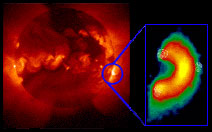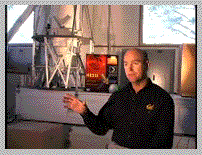|
Berkeley/NASA
satellite to launch February 5 on mission to study solar flares
31 January 2002
By
Robert Sanders, Media Relations
|

|
|
A
1992 picture (left) of the two million-degree solar atmosphere glowing
in soft X-rays, taken with the Soft X-Ray Telescope on the joint
Japan-U.S. Yohkoh mission. At right is a blow-up of a flare as seen
with Yohkoh in soft and hard X-rays. (hi-res
version)
NASA
photo
Additional
information for the media
|
Berkeley
— A satellite
dedicated solely to the study of solar flares and designed, built and
operated by an international consortium led by scientists at the University
of California, Berkeley, is set for launch on Tuesday, February 5, by
the National Aeronautics and Space Administration (NASA).
The High
Energy Solar Spectroscopic Imager, or HESSI, will embark
on a two- to three-year mission to look at high-energy X-ray
and gamma ray emissions from solar flares — enormous
explosions in the solar atmosphere. Though various satellites
have made X-ray and gamma ray observations of flares, HESSI
will be the first to snap pictures in gamma rays and the
highest energy X-rays.
"With
intense flares, we can take X-ray images with very high
resolution, very fast, and create movies of flares lasting
from 10 seconds to tens of minutes," said Robert P. Lin,
professor of physics in the College of Letters & Science
at UC Berkeley and principal investigator for the mission.
Lin also is director of UC Berkeley's Space Sciences Laboratory.
Using
these images, plus X-ray and gamma-ray spectra with unprecedented
energy resolution, the scientists hope to discover what
triggers flares and how energy stored in the solar magnetic
fields is suddenly released to accelerate particles to very
high speeds and to heat the gases in the solar atmosphere
to tens of millions of degrees.
"From
these hard X-ray and gamma-ray measurements, we can reconstruct
the energy distribution of the particles and trace back
to where everything was accelerated," Lin said.
The mission
begins near the peak of the sun's 11-year cycle of activity,
providing an unprecedented opportunity for study of these
explosive events. What scientists learn will give insight
into the processes that accelerate other particles whizzing
at nearly light-speed through the universe.
HESSI is the sixth
Small Explorer (SMEX) spacecraft scheduled for launch under NASA's
Explorers Program. Total cost for the mission, including the spacecraft,
launch vehicle and mission operations, is about $85 million.
Solar
flares, along with the often associated explosions called
coronal mass ejections, are the solar events that most affect
"space weather." The intense energy associated with these
events — up to the equivalent of a billion megatons
of TNT — and the energetic particles they throw out
impact the Earth's magnetic field, compressing it and interfering
with radio communications on Earth. Astronauts and cosmonauts
aboard the International Space Station or the Space Shuttle
also can receive dangerous doses of radiation from the high-energy
particles.
 |
| HESSI
project manager Peter Harvey. Lauren Garcia photo |
"Coronal
mass ejections sometimes have flares associated with them
and sometimes don't," said Brian Dennis, HESSI mission scientist
at NASA's Goddard Space Flight Center in Greenbelt, Md.
"We don't understand why this should be or what the relationship
is between these two types of events."
The 645-pound (293
kilograms) HESSI satellite will be launched atop a Pegasus XL rocket
dropped from the belly of an L-1011 aircraft flying out of Cape Canaveral
Air Force Station, Florida. After the plane reaches an altitude of
about 40,000 feet over the Atlantic Ocean, the rocket will be released
to free-fall in a horizontal position for about five seconds before
igniting its first stage motor. The three-stage rocket will place the
spacecraft into a circular orbit about 373 miles (600 kilometers) above
the Earth, inclined at 38 degrees to the equator.
>>
continued

HESSI project manager Peter Harvey details satellite launch
and orbital insertion.
(requires
RealPlayer)
|